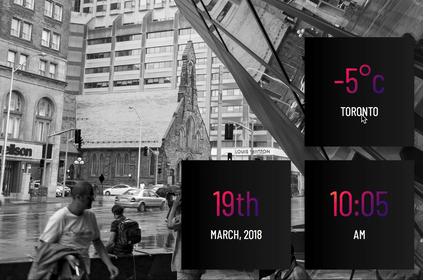Introduction to React Motion Tutorial
React Motion is an animation library loved within the React community. I have to say that having some experience with libraries like GSAP, it isn't the easiest to comprehend, but its power comes from the ability to directly tie animations to your state. Just like React, state dictates when your React components will render, and likewise, state dictates the animations in React motion.

In this demo we'll animate a div which contains the weekly forecast into and off of the screen. Let's say we have this code below:
<Forecast>{weather.forecast.map(daily => (<Dailykey={daily.date}date={daily.date}low={daily.low}high={daily.high}/>))}</Forecast>
In the above code Forecast is a styled-component, so in reality it is just a div. In the examples below we won't include the mapping that happens inside of the Forecast component because it isn't required for this example.
Video tutorial
If you'd prefer a video tutorial of this article, please check out my YouTube video below.
Introducing React Motion
To start with React Motion, we'll want to import 2 libraries:
import { Motion, spring } from "react-motion";
Motion will be used to wrap around our Forecast component and spring is a function which controls the speed in which a number will animate from its beginning value to the ending value. Let's show the final version of the animation below, and then we'll break down the different parts of it.
<MotiondefaultStyle={{ x: -200, opacity: 0 }}style={{x: spring(showForecast ? 0 : -200),opacity: spring(showForecast ? 1 : 0)}}>{style => (<Forecaststyle={{transform: `translateX(${style.x}px)`,opacity: style.opacity}}>mapping daily forecast...</Forecast>)}</Motion>
Default Style & Style
The Motion component receives 2 props, defualtStyle and style. defaultStyle is an object which defines the initial values that you wish to animate. In this case we'll be animating an x value which will start at -200, and opacity which starts at 0.
The style prop is an object of what the values should be at any point in time. If defualtStyle is the from of the animation, style is the to (in gsap terminology).
But you'll notice that the style prop isn't so simple. x: spring(showForecast ? 0 : -200) what we're actually doing is tying it to the state, specifically the showForecast value of the state which is a boolean value. So what we're saying is that if showForecast is true, we want the value to be 0, but if it is false, it should be back at -200.
What about spring?
So what does spring do then? It's a function which controls the animation's speed. If the value went from -200 to 0 instantly, it wouldn't appear to be animating, it would just happen. spring causes it to gradually transition from it's from to its to.
spring can be sent a 2nd parameter which is an object that could look like this: {stiffness: 170, damping: 26}. This terminology comes from physics, but essentially stiffness controls the speed of the animation, and damping controls the bounciness. This page provides a playground for determining which stiffness and damping settings are right from you.
In React Motion you never define how many milliseconds the animation will take, it is only controlled by stiffness and damping.
Using the animated values
The Motion component wants to receive a function as its child.
<Motion>{style => <Forecast>contents</Forecast>}</Motion>
This function is passed the current style as its being animated from one value to another... so it is being constantly called as the values change. It might look like this:
{ x: -150.25, opacity: 0.264 }
So now that we have the values as they are being animated, we can use them with an inline style to change the css properties.
<Motion>{style => (<Forecaststyle={{transform: `translateX(${style.x}px)`,opacity: style.opacity}}>mapping daily forecast...</Forecast>)}</Motion>
We're using the style object to change the transform css property and the opacity property. Now as these inline styles change, and our Forecast component slides onto the screen, it is because the x value went from -200 (px) to 0 (px). And the opacity went from 0 (invisible) to 1 (visible).
Now all you need to animate the Forecast component into and off of the screen is to change the state's showForecast value, and as its changed, spring and Motion will animate the properties back and forth.
Conclusion
Today we looked at React Motion, one of the many animation libraries out there, but one that works particularly well with React. Other great libraries to look into are popmotion.io, anime.js, gsap, and react-transition-group. I highly recommend following Sarah Drasner when it comes to animations on the web, and she has a great book called SVG Animations which comes with a full chapter on React integration.